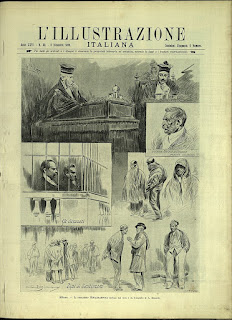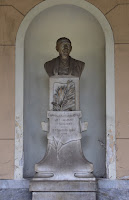Painter was dubbed the Raphael of Bergamo
 |
| Enea Salmeggia's Il Martirio di Sant’Alessandro is one of his most famous paintings |
Salmeggia, also known as Il Talpino, or Salmezza, went to Rome as a young man, where he studied the works of Raphael. His style has often been likened to that of Raphael and he has even been called the Bergamo Raphael by some art lovers. A drawing formerly attributed to Raphael, now in the Ashmolean Museum in Oxford, of two figures seated with some architectural studies, has subsequently been ascribed to Enea Salmeggia.
The artist was born at Salmezza, a frazione of Nembro, a comune - municipality - in the province of Bergamo, between 1565 and 1570. It is known that he grew up in Borgo San Leonardo in Bergamo, where his father, Antonio, was a tailor.
He learnt the art of painting from other Bergamo painters and is also believed to have studied under the Bergamo artist Simone Peterzano in Milan. Caravaggio was one of Peterzano’s most famous pupils and it has been suggested that Salmeggia could have been studying with Peterzano at the same time as Caravaggio.
 |
| Enea's Madonna col Bambino e santi Ambrogio e Carlo Borromeo |
The artist married Vittoria Daverio, the sister of Milanese sculptor Pietro Antonio Daverio, and they had six children. Two of their children died from the plague and one went into a monastery, but his daughters, Chiara and Elisabetta, and his son, Francesco, worked in his studio near the Church of Sant’Alessandro in Colonna in Bergamo and later became painters themselves.
One of Salmeggia’s most famous works, Il Martirio di Sant’Alessandro, an oil on canvas in the choir of the Church of Sant'Alessandro in Colonna, was completed in 1623.
Among the other churches with paintings by Salmeggia are Sant’Andrea and Santi Bartolomeo e Stefano in Bergamo, Sant’Afra in Brescia, San Francesco in Lodi, San Vittorio in Terno d’Isola and San Gregorio in Gromo.
The Accademia Carrara in Bergamo has works by Salmeggia, including his Portrait of a Gentleman. The Pinacoteca del Castello Sforzesco in Milan also has paintings by Salmeggia, including his Madonna col Bambino e santi Ambrogio e Carlo Borremeo.
Salmeggia died in 1626 and was buried in the Church of Sant’Alessandro in Colonna.
 |
| The parish church of San Martino in the centre of Nembro |
Nembro, the suburb of Bergamo in which Enea Salmeggia was born, can be found about 9km (5 miles) northwest of the city of Bergamo, on the right bank of the Serio river. The surrounding countryside is popular with walkers, with many defined paths in the hills above the town, one of which leads to the Santuario della Madonna dello Zuccarello, built in 1374 by the nobleman Bernardo Vitalba. The town itself surrounds the parish church of San Martino, erected in the ninth century but rebuilt in the 18th century, which contains no fewer than 27 of Salmeggia’s paintings. In recent history, Nembro was notable as one of the areas of Bergamo worst hit by the Covid-19 pandemic, with 188 known to have died from the disease, 94 in the first 15 days. On average, every household in Nembro mourned at least one family member.
Stay in Nembro with Booking.com
.jpg) |
| The Festa di Sant'Alessandro sees the church facade illuminated |
The Chiesa di Sant’Alessandro in Colonna in Via Sant’Alessandro in Bergamo is the church of the city’s patron saint. Outside the church is a Roman column, said to have been erected in the exact spot where Alessandro was executed by the Romans. The column was constructed in the 17th century from Roman fragments and there are various theories about where the pieces came from. The church of Sant’Alessandro in Colonna was rebuilt in the 18th century on the site of an earlier church. Its ornate campanile was completed at the beginning of the 20th century. Over several days each August, the facade of the church is illuminated as part of the Festa di Sant’Alessandro, marking the anniversary of his execution in 303.
Accommodation choices in Bergamo from Booking.com
More reading:
The Bergamo painter who left a visual record of changing society
The Bergamo shoemaker’s son who became internationally acclaimed sculptor
Raphael - the precocious genius from Urbino
Also on this day:
1682: The birth of anatomist Giovanni Battista Morgagni
1707: The birth of Venetian playwright Carlo Goldoni
1866: The birth of philosopher and historian Benedetto Croce
1873: The birth of tenor Enrico Caruso
2003: The death of actor Alberto Sordi
(Picture credits: Nembro church by Giorces via Wikimedia Commons)
(Paintings: Il Martirio di Sant’Alessandro, Galleria dell Accademia Carrara, Bergamo; Madonna col Bambino e santi Ambrogio e Carlo Borromeo, Pinacoteca del Castello Sforzesco, Milan)
.jpg)

.jpg)
.jpg)
.jpg)
.jpg)



.jpg)







.jpg)
.jpg)


.jpg)


.jpg)

.jpg)
.jpg)
